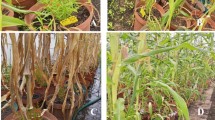Abstract
The (E)-ferulic acid content of the grain of nine populations of land races of maize derived from CIMMYT's collections was found to be negatively correlated to susceptibility characteristics towards the maize weevilSitophilus zeamais. Correlation coefficients for six susceptibility parameters and (E)-ferulic acid content were significant and ranged from −0.58 to −0.79. A multiple regression analysis by the SAS forward procedure using the primary seed characteristics associated with susceptibility indicated that the ferulic acid content was the only significant factor in explaining variation in at least two susceptibility parameters: the Dobie index and adult preference. In 15 CIMMYT pools, correlations between four susceptibility parameters and (E)-ferulic acid content were also significant (−0.76 to −0.81). The results suggest that phenolic acid content is a leading indicator of grain resistance or susceptibility to insects and may represent a newly identified mechanism of resistance.
Similar content being viewed by others
References
Borne, M.C. 1982. Food Texture and Viscosity: Concept and Measurement. Academic Press.
Buckley, D.J., Timbers, G.E., Kloek, M., andLalonde, M.J.L. 1984. Texture profile analysis with curve smoothing using a personal computer.J. Texture Stud. 15:247–261.
Dobie, P. 1977. The contribution of the Tropical Stored Products Center to the study of insect resistance in stored maize.Trop. Stored Prod. Inf. 34:7–22.
Eden, W.G. 1952. Effects of kernel characteristics and components of husk cover on rice weevil damage to corn.J. Econ. Entomol. 45:1084–1085.
Fortier, G., Arnason, J.T., Lambert, J.D.H., McNeill, J., Nozzolillo, C., andPhilogéne, B.J.R. 1982. Local and improved corns in small farm agriculture in Belize.Phytoprotection 63:68–78.
Fry, S.C. 1983. Feruloylated pectins from the primary cell wall: Their structure and possible functions.Planta 157:111–123.
Gomez, L.A., Rodriguez, J.G., Poneleit, C.G., andBlake, D.F. 1982. Preference and utilization of maize endosperm variants by the rice weevil.J. Econ. Entomol. 75:363–367.
Gomez, L.A., Rodriguez, J.G., Poneleit, C.G., Blake, D.F., andSmith, C.R. 1983. Influence of nutritional characteristics of selected corn genotypes on food utilization by the rice weevil,Sitophilus oryzae.J. Econ. Entomol 76:728–732.
Lewis, N.G., Yamamoto, E., Wooten, J.B., Just, G., Ohashi, H., andTowers, G.H.N. 1987. Monitoring biosynthesis of wheat cell wall phenyl propanoids in situ.Science 237:1344–1346.
McCain, F.S., andEden, W.G. 1965. Can hydrids be sought with built in insect resistance?Crops Soils 17:27–28.
Milner, M., Barney, D.L., andShellenberger, J.A. 1950. Use of selective fluorescent stains to detect insect egg plugs on grain kernels.Science 112:791–792.
Pussayanawin, V., andWetzel, D.L. 1987. High performance liquid chromatography determination of ferulic acid in wheat milling fractions as a measure of bran contamination.J. Chromatogr. 391:243–255.
Ribereau-Gayon, P. 1972. Plant Phenolics. Oliver and Boyd, Edinburgh.
Schoonhoven, A.V., Horber, E., andMill, R.B. 1976. Conditions modifying expression of resistance of maize kernels of the maize weevil.Environ. Entomol. 5:163–168.
Serratos, A., Arnason, J.T., Nozzolillo, C., Lambert, J.D.H., Philogéne, B.J.R., Fulcher, G., Davidson, K., Peacock, L., Atkinson, J., andMorand, P. 1987. The factors contributing to resistance of exotic maize populations to maize weevilSitophilus zeamais.J. Chem. Ecol. 13:751–762.
Serratos, A., 1988. The resistance of maize germplasm toSitophilus zeamais infestation. M.S.C. Thesis, University of Ottawa.
Singh, D.N., andMcCain, F.S. 1963. Relationship of some nutritional properties of corn kernel to weevil infestation.Crop Sci. 3:259–261.
Sosulski, F., Krygier, K., andHogge, L. 1982. Free, esterified and bound phenolic acids. 3. Composition of phenolic acids in cereal and potato flours.J. Agric. Food Chem. 30:337–340.
Van Der Schaaf, P., Wilbur, D.A., andPainter, R.H. 1969. Resistance of corn to laboratory infestation of the larger rice weevilSitophilus zeamais.J. Econ. Entomol. 62:352–355.
Wellhausen, E.J.,Roberts, L.M., andHernandez, E. 1951. Razas de Maiz en Mexico Su origen, caracteristicas y distribucion. Folleto Tecnico No. 5. S.A.G. Mexico, D.F.
Widstrom, N.W., Hanson, W.D., andRedlinger, L.M. 1975. Inheritance of maize weevil resistance in maize.Crop Sci. 15:467–470.
Widstrom, N., McMillian, W., andWiseman, B.R. 1978. Improving effectiveness of measurements for seed resistance to maize weevil.J. Econ. Entomol. 71:91–93.
Author information
Authors and Affiliations
Rights and permissions
About this article
Cite this article
Classen, D., Arnason, J.T., Serratos, J.A. et al. Correlation of phenolic acid content of maize to resistance toSitophilus zeamais, the maize weevil, in CIMMYT'S collections. J Chem Ecol 16, 301–315 (1990). https://doi.org/10.1007/BF01021766
Received:
Accepted:
Issue Date:
DOI: https://doi.org/10.1007/BF01021766




